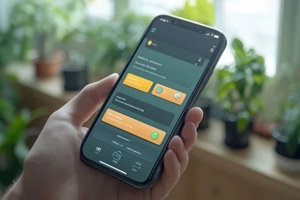In application development, creating a user-friendly application is essential for driving adoption, improving overall productivity, and maintaining user satisfaction. With stiff competition for user attention, applications must meet user needs while offering seamless navigation, consistent design, and optimal performance.
A well-designed app reduces user frustration, boosts efficiency, and appeals to an assorted audience, including those with accessibility needs.
Comprehending User Needs and Goals
To make an application that users truly value, focus on comprehending who they are and what they need. Begin by building user personas, which are detailed profiles representing your audience’s tasks, challenges, and goals.
Here, you want to carefully consider their demographics, habits, and underlying motivations, as this helps you anticipate what they want and design features that genuinely help them.
 Consider users’ common frustrations; they may struggle with repetitive tasks or complex workflows. You can then use this knowledge to solve specific problems through functionality that streamlines their experience.
Consider users’ common frustrations; they may struggle with repetitive tasks or complex workflows. You can then use this knowledge to solve specific problems through functionality that streamlines their experience.
For example, automating repetitive tasks or designing shortcuts for commonly used actions can boost general user productivity and even ease workload pressures. When your application feels as though it’s designed with real people in mind, users are more likely to engage with it and stay loyal over the long term.
Simplify Navigation and Information Architecture
It’s important to create an experience where users can quickly and easily access what they need without any hassle. Your menus and options should feel natural and be located precisely where users would expect them to be.
Consider the flow of their actions and what they’ll click on next, and design your navigation to match those patterns. Usability testing is a powerful way to confirm if your setup works. Watching how real users interact with your app can reveal what feels intuitive and what doesn’t.
A clear hierarchy is just as important, so organize features and tools under logical headings, grouping related items together. For instance, put editing tools in one section and settings in another.
Having clean, logical structures helps users focus on tasks instead of searching aimlessly. When everything is thoughtfully organized, users spend less time navigating and more time accomplishing their goals.
Establish Consistent Design Across the Application
Consistency in design makes your app feel dependable and easy to use. A design system or style guide helps you stick to the same colors, buttons, fonts, and other visual elements throughout the app. When users see familiar elements across every screen, they know what to expect, building confidence and making interactions smoother.
Uniform layouts are just as important, and using the same structure on different screens allows users to get around the app effortlessly without having to relearn where things are.
Predictable layouts simplify the experience, helping people focus on their tasks rather than figuring out your user interface. When everything looks and feels cohesive, your app becomes a trusted tool users can rely on, no matter where they are within it.
Optimize Performance and Speed
Nobody likes waiting, especially when using an app. Having fast load times keeps users engaged and makes your application feel responsive.
Try to compress images, streamline backend processes, and remove unnecessary code to reduce delays. Fast and efficient interactions can contribute to a smoother user experience and help leave a positive impression.
 Testing your app’s performance across different devices is just as important. Phones, tablets, and desktops all handle apps differently; regular testing helps you catch issues before they frustrate users.
Testing your app’s performance across different devices is just as important. Phones, tablets, and desktops all handle apps differently; regular testing helps you catch issues before they frustrate users.
Tools such as performance profilers and load-testing software can pinpoint bottlenecks and help you fine-tune for speed. When your app responds quickly and consistently, users are likely to stick with it and accomplish their goals without distraction.
Incorporate Clear and Helpful Feedback Loops
Let users know their actions matter; a quick confirmation, like a message or a visual cue after submitting a form, reassures them that things are working as expected. These small signals in application development can help keep users confident when using the app and reduce confusion about what’s happening.
When problems happen, a clear and concise error message can significantly affect how users react. With them, you want to focus on being as specific and actionable as possible.
For instance, rather than having “Error 404” on a page, try to guide users by saying, “The page you’re looking for isn’t available. Try checking the URL.” Simply put, you want to avoid technical jargon and keep the message as straightforward as possible.
Prioritizing Accessibility in the Design
Prioritizing accessibility in your application development makes it more inclusive and easier for everyone. Moves such as incorporating full keyboard navigation are a simple way to accommodate users with limited mobility.
Think about performing tasks such as filling out forms, navigating menus, or triggering actions, all without a mouse. This feature doesn’t just help people with disabilities but also benefits power users who prefer using keyboard shortcuts to get things done.
Screen reader compatibility opens your app to visually impaired users, and adding descriptive alt text to images and meaningful labels to buttons allows screen readers to translate your interface into audio.
Using ARIA roles enhances the clarity of interactive elements, improving the overall experience for assistive technology users. Designing with accessibility in mind creates an app that works for more people, letting everyone enjoy its benefits and interact easily.
Let’s Build a User-Focused Solution Together
 A great app keeps usability, performance, and accessibility at its core, delivering a seamless experience that meets user expectations.
A great app keeps usability, performance, and accessibility at its core, delivering a seamless experience that meets user expectations.
In application development, satisfaction and engagement naturally follow when you align your features with what users genuinely need. Listening to ongoing user feedback and making continuous improvements over time also keeps your app relevant in the face of increasingly stiff competition.
Ready to create an app that’s intuitive and user-focused? Orases can help develop a custom solution that best meets your needs. Let’s build something that works beautifully for your users and your organization. Schedule a consultation online or give us a call at 1.301.756.5527 to get started today.






